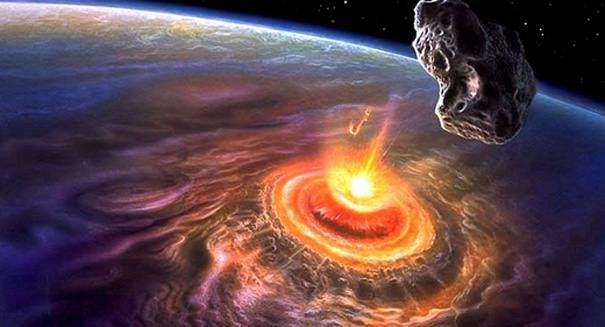
A new theory on his humans evolved.
Almost 13,000 years ago, the Earth experienced a dramatic shift in climate that took out many of the planet’s large mammals and changed the course of our earliest ancestors. Scientists have been trying to understand the phenomenon, which they call the “Younger Dryas,” and a new study published Monday in the Journal Proceedings of the National Academy of Sciences may have found the answer in a comet that crashed near the Gulf of Saint Lawrence, in northeastern Canada and near North America’s Atlantic coast.
The study’s researchers, from Dartmouth College, explain that the “Younger Dryas” period was a point in time when the Earth cooled rapidly, killing off most of the large mammals that could not adapt such as mastodons, giant sloths and camels. Some of the early hunters, such the Clovis people, also disappeared during this time. When other early hunters lost their main source of food, they shifted their behavior to a hunter-gatherer lifestyle by subsisting on smaller game and foraging for berries and roots.
“The Younger Dryas cooling impacted human history in a profound manner,” says Dartmouth Professor Mukul Sharma, a co-author of the study. “Environmental stresses may also have caused Natufians in the Near East to settle down for the first time and pursue agriculture.”
Researchers agree the earth’s climate shifted dramatically all those years ago; however, they have yet been able to come to a consensus on how that change occurred. Some researchers believe an ice dam in the North American ice sheet ruptured, flooding the St. Lawrence and Mackenzie Rivers and flushing cold freshwater into the North Atlantic Ocean and shutting down its currents, causing the massive cooling.
In 2007, some researchers formed a new theory suggesting that comets may have caused the climate shift. Sharma and his team followed up on that theory, studying the geochemical signature of molten rock droplets recovered from the Younger Dryas boundary layers in Pennsylvania and New Jersey. They traced those spherules back to their source, the 1.5-billion-year-old Quebecia terrane near the Gulf of Saint Lawrence. At the time of the impact, a continental ice sheet covered the region, similar to what Antarctica is today.
Their research has been met with skepticism by the scientific community. Nicholas Pinter, a geologist at Southern Illinois University in Carbondale, dubbed the study “fringe science.” However, Sharma remains confident that the spherules from the Northeast American sites do link up to the Younger Dryas cooling. He concluded, “We have for the first time narrowed down the region where a Younger Dryas impact did take place, even though we have not yet found its crater.”
Leave a Reply